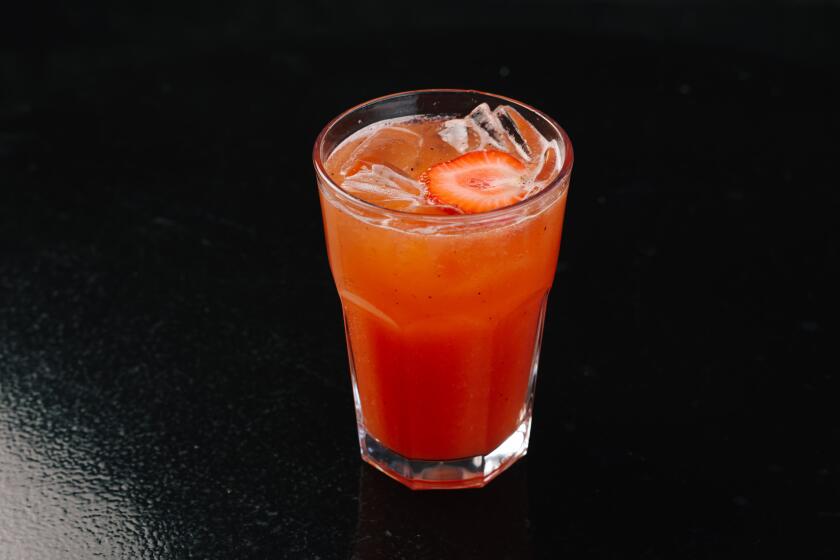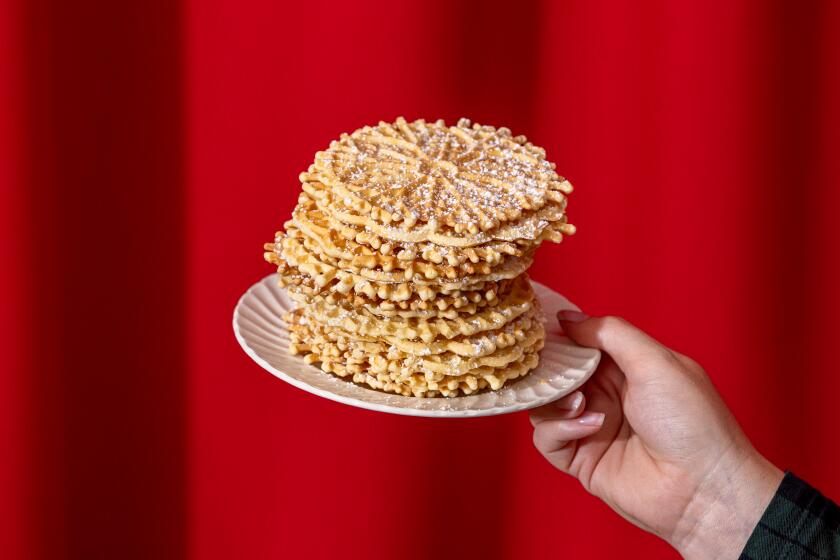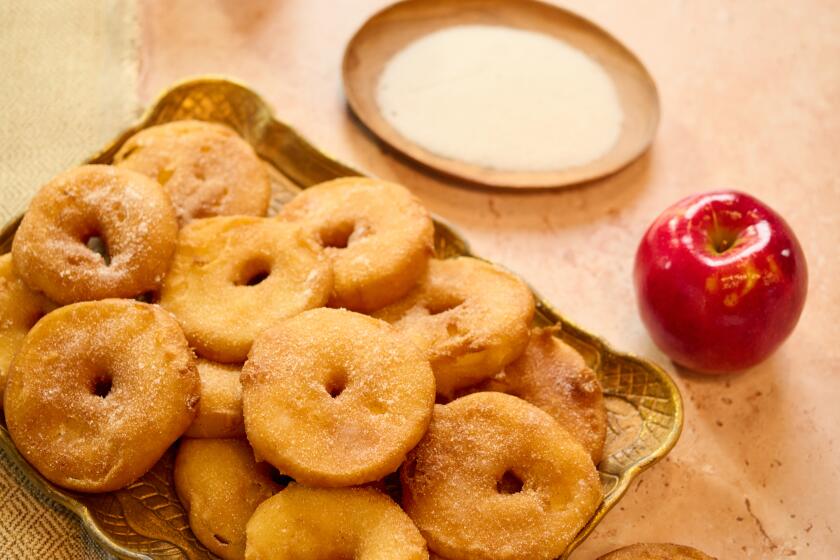Adam Perry Lang's gravy

These days, when you see Adam Perry Lang cooking, you’re more likely to see him inside a weather system of barbecue smoke on Jimmy Kimmel’s backlot than you are basting a roasting turkey with a Home Depot spray bottle. Yet that’s what the chef was doing on a recent afternoon in the kitchen of his Manhattan Beach house. If you’re thinking that Perry Lang builds his Thanksgiving turkey inside a massive custom-made metal smoker, as he does the Angus beef ribs for which he’s become justly famous, you’d be wrong — at least this year.
Perry Lang navigates the compact space of his kitchen with the speed and precision you’d expect from someone who’s worked in one all his adult life. He simultaneously attended the Culinary Institute of America in Hyde Park, N.Y., and worked at Le Cirque for Daniel Boulud, the French chef who made the restaurant one of the best in New York City. Perry Lang narrates this year’s holiday menu as he works — traditional dishes patched together from his childhood in Long Island and his peripatetic restaurant life, now 30 years of working in London and France and on both coasts of America.
“Family holidays were a big deal. My mother is a tremendous cook, and she does her best with the tchotchkes and napkin holders,” Perry Lang says as he flips a mixture of shallots, garlic and celery in a saute pan for the dressing. “I started identifying with Thanksgiving when we came back to America. Fleur had never had one; she’d never had a turkey.” Perry Lang met his Paris-born wife, Fleur, in France, where he’d gone after graduating from cooking school and helping Boulud open Daniel in New York. With Boulud’s help, Perry Lang went to work for Guy Savoy. He’d been taking a break to learn French through a Berlitz course when he met his future wife in a cafe bar. They have two children, 12-year-old Max and 9-year-old Noa, who, dressed in a tuxedo jacket, is acting as her father’s sous chef, peeling shallots.
This year, Perry Lang’s turkey is one he bought from his local butcher, whom he credits with this year’s method as well as the bird. “He asked if I wanted any tips on how to cook it,” says the chef, who has also written three cookbooks. “And I thought, ‘Why not?’” Perry Lang says he was told to roast it upside down, then flip it midway. “Give this kid credit for flipping the bird,” the chef says, smiling as he does indeed flip his turkey, covering it again with a butter-soaked cheesecloth like a kind of Gallic shroud.
The story of the butcher and the bird is emblematic, as Perry Lang has spent his career adapting to radically new environments, synthesizing what he’s learned and finding through-lines that he uses like kitchen twine.
“Barbecue and French cooking aren’t so far apart; neither is Thanksgiving,” he says, again hitting his turkey with the Home Depot spray bottle, which is filled with a mixture of melted butter and apple cider vinegar. The spray bottle is a technique he uses when he barbecues, something that he’s been doing since he returned to New York. Because after a stint working for Marc Meneau in Burgundy, the chef opened, of all things, a barbecue joint called Daisy May’s.
To hear him tell it, the story of Perry Lang’s segue from Michelin-starred French restaurants to barbecue pits isn’t a crazy anomaly so much as a logical trajectory, from a set of orderly kitchen fires to live fire. “There are lots of parallels between French cooking and barbecue, including the snobbery.” He adjusts the low fire on his own stove, rendering chicken skin, sauteing parsnips and charring radicchio, all of which will go into a holiday side dish. The journey to the fires of barbecue cooking was as much part of the road home as was bringing his family back to New York and ultimately to Los Angeles. (Along that road, Perry Lang spent a few years opening restaurants with Jamie Oliver in London and working with Mario Batali and Joe Bastianich on a dry-aged beef program in Las Vegas.) While in New York, Perry Lang met late-night TV host Kimmel, and they bonded over cooking and fly-fishing.
So Perry Lang started commuting across the country to do barbecue pop-ups on the “Jimmy Kimmel Live” parking lot and settled in Los Angeles. He and his family moved into a house near the beach, and Perry Lang started looking for a place to open a restaurant. Called APL (“it’s an intensely personal restaurant”), the 150-seat restaurant will open next year on the ground floor of the Taft Building, a restored 1924 high-rise on the corner of Hollywood Boulevard and Vine Street in Hollywood. And no, it’s not a barbecue joint, rather it’s an American restaurant — although Perry Lang says he’ll likely have a walk-up window where you can order some barbecue too.
Windows are something of a recurring motif for Perry Lang (“My cooking is about windows; every food has its flavor window”) about ingredients and technique, as well as about his career. This is perhaps unsurprising, given the amount of heat and smoke in his environment. The window he’s opening now is onto the Pacific, a block away from his home kitchen, which forms the horizon behind the table he’s gradually been loading with this year’s feast.
Perry Lang sets out a pumpkin pie the size of a hubcap, its crust a thick circle of burnished pastry (“almost like a fried cannoli shell”), and whips heavy cream by hand in a bowl set deep into his sink, adding maple syrup and a hefty toss of salt. As his family and friends gather around the long table, Perry Lang carves the bird, dipping slices into a shallow pan of melted butter into which he’s grated black truffles. “Intense, right?” It’s another of his barbecue tricks, although exactly where Perry Lang’s tricks come from — New York City fine-dining restaurants, Texas barbecue pits, the food palaces of France — is sometimes difficult to tell. What is abundantly clear is that this is comfort food, driven by technique and not a little obsessiveness, the table its own window. Aren’t they all?
Make a beurre manié: Knead together the unsalted butter and flour to form a sort of paste. Roll the paste into a log about 1/2-inch thick and wrap tightly in plastic wrap. Store in the freezer.
In a large saute pan heated over medium-high heat, add the oil, then the turkey bones and chicken legs, in batches (they will need to be cooked in a single layer), until browned, 10 to 15 minutes for each batch. Add additional oil if needed for each additional batch. Remove the bones and legs (save the leg meat for another use).
Reduce the heat to medium-low and add the butter to the pan, cooking until it is melted and lightly browned. Stir in the shallots, along with a little extra oil if desired so there is plenty of fat in the pan. Cook the shallots, stirring frequently, until they are golden-brown, 5 to 7 minutes. Add the white wine and cook, scraping any flavoring from the bottom of the pan, until the wine is evaporated or absorbed into the shallots.
Add about 1½ cups warm broth and simmer until the broth is reduced to a thick, jam-like consistency. Repeat this process twice more, reducing until the broth is thickened and jam-like in consistency.
Add the remaining stock and reduce by half. Add the bay leaves, sage, thyme and rosemary to the pan. Season with 1/4 teaspoon salt and several grinds of black pepper, or to taste. Heat over very low heat for 20 minutes to give the flavors time to marry, then remove the herbs (and strain the gravy, if desired, for a smoother sauce). Bring the gravy back to a simmer and whisk in the beurre manie, a little at a time, until the gravy is thickened to taste.
The gravy can be made up to a few hours in advance and kept warm in a thermos.
Get our Cooking newsletter.
Your roundup of inspiring recipes and kitchen tricks.
You may occasionally receive promotional content from the Los Angeles Times.















